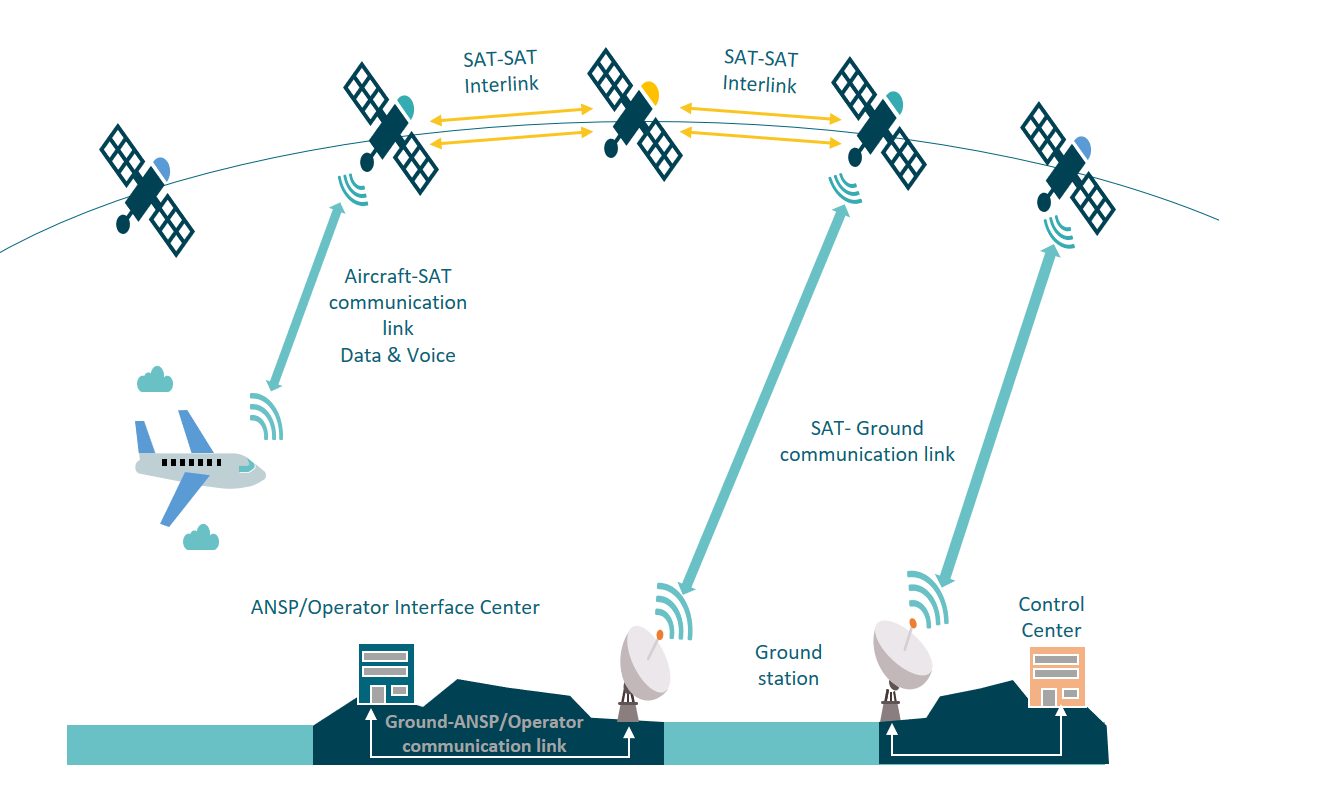
-
StatusOngoing
-
Status date2023-11-27
-
Activity Code6B.107
The objective of the project is to design and prototype (TRL4) a Routing Solution for Low Earth Orbit (LEO) constellations that support critical services and require a highly performant solution. This solution provides robust and low latency IP connectivity among all nodes despite frequent changes in topology and potential link or node failures.

The Routing Solution is a fundamental enabler for a planned safety-critical LEO satellite communication system, the Space-Based-CNS system, which is composed by a medium-sized constellation of small LEO satellites connected via inter-satellite links, combined with a terrestrial network of redundant ground system elements. The target of this LEO satellite system is to provide safety-critical Communication (C) and Surveillance (S) services for Air Traffic Management (ATM), which are characterized by very demanding requirements in terms of safety, security, availability, latency and continuity.
The following main services will be served via this routing solution:
-
Analog VHF voice
-
ATS Data Services (CPDLC, ADS-C, CM…)
-
AOC Services
-
ADS-B
The solution has also the potential to be commercialized on its own, because it can be suitable also for other constellations with similar requirements, especially in terms of software assurance level, high reliability and QoS-awareness.
LEO satellite constellations can be described as highly dynamic environments, where satellite movements cause frequent, although generally predictable changes in the network topology. These networks are characterized by a discontinuous operation of inter-satellite links (ISLs), especially of cross-plane ISLs in polar areas, and by short contact times between satellites and ground stations. To support safety-critical ATM services using a LEO constellation, it is necessary that the routing elements on-board and on-ground are able to cope also with other predictable and unpredictable topology changes resulting from spacecraft maintenance operations or failures, ground station failures or degraded channel conditions.
Although routing issues in LEO constellation have been already researched extensively in the past, this has not lead to a commonly adopted solution and to the availability of commercial products. Currently, existing LEO constellations have each come up with their own proprietary and customized routing approaches, adapted to the specificities of their networks. Additionally, the planned Space-based CNS system actually has a number of particularities that would make these solutions not fully suitable, as for example its safety nature and its specific traffic profile.
Therefore, the development of the Routing Solution is considered a critical technology development activity for the Space-based CNS system. The Routing Solution acts as enabler allowing compliance with rather demanding requirements in terms of safety, security, availability, latency and continuity and it is a fundamental element for the overall success of the targeted ATM services (voice, data and ADS-B).
The Routing Solution supports the following features:
-
Safety nature. The safety nature of the system places very strict requirements in terms of latency, packet loss and so on, which are much more stringent than for other communication systems. A key requirement is also the support of latency–sensitive voice services. This means that predictable topology changes (e.g., ground station handovers) should have a minimal impact in terms of losses or extra delays.
-
Focus on remote areas. The targeted services focus on providing services over oceanic and other remote areas. So connectivity over polar areas, which may be neglected to some extent by other communication systems, is critical as well. It should thus be adequately tackled despite the specific routing and ISL connectivity problems within these areas.
-
Specific traffic profile. The Space-based CNS system has to be not only topology but also QoS-aware. Services with very different latency requirements have to co-exist and there is a need to handle congestion events that may jeopardize the compliance with latency requirements. However, the ATM service traffic profile is rather specific and different from the typical Internet access traffic profile that is taken as reference for other commercial LEO constellations.
The Routing Solution architecture has two main components, described below.
-
Routing Manager. The Routing Manager executes actions and protocols as required in order to generate the control plane information (generally in the form of forwarding tables) required by the packet forwarding function within a spacecraft or ground node. With this purpose, it interacts with the Routing Controller on-ground and also with other Routing Managers in other network nodes, in order to support routing protocol operations. It takes into account also local interface status information in order to drive the routing logic.
-
Routing Controller. The Routing Controller is a centralized module running on a ground node which supports more seamless routing by providing Routing Managers with configuration information that is based on the predicted topology. It interfaces the system management modules in order to obtain data needed to derive this information (satellite TLE, ground station contact plans…).
With a duration of 18 months, this project is dedicated to implement the Technology Phase of the Routing Solution of the SB-CNS system. At the end of the project the Preliminary Design Review will be held in order to verify the preliminary design of the selected concept and demonstrate its feasibility. Four Review Meetings will be held every 3 months in order to verify the status of the project and their activities. A Final Review at T0+18 will be celebrated to close the project and summarize the results.
After 1 year of activities, the project status is the following:
-
The design of the Routing solution has been finalized and the verification phase has been started.
-
The ESA Review Meetings #2 and #3 have been carried out successfully in June and October 2023 respectively.
-
The next review milestone is planned on January 2024 where the final breadboarding test bed results and the first results of the emulation test bed will be presented.
Indra performs these activities with the support of Universitat Politecnica de Catalunya (UPC) and Universidad Politécnica de Cartagena (UPCT).



